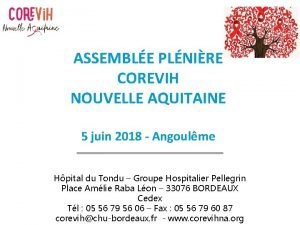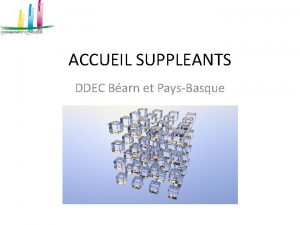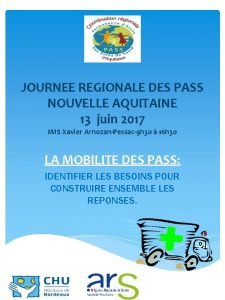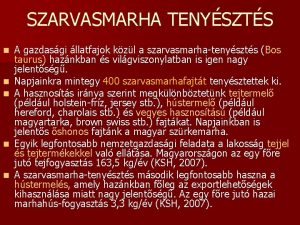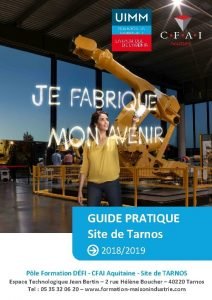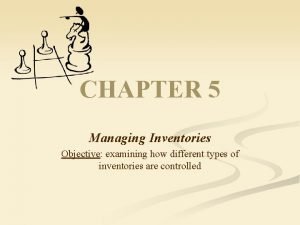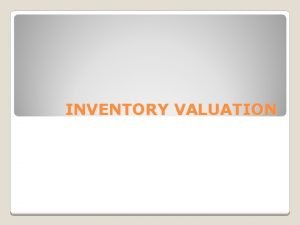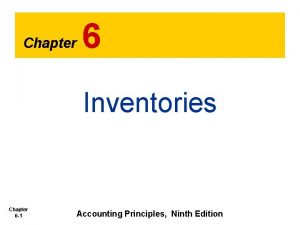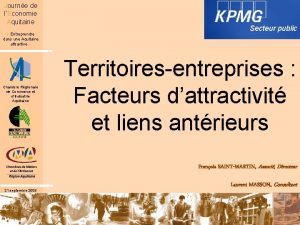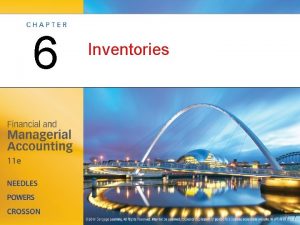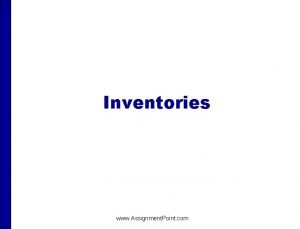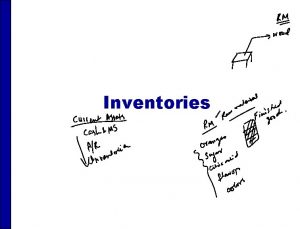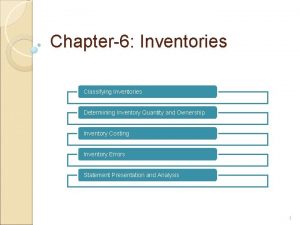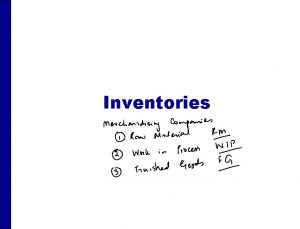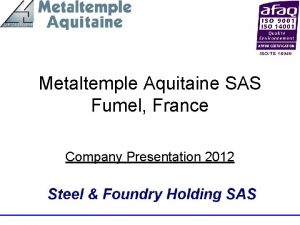EXAMPLES OF INVENTORIES 3 examples Aquitaine in France


















- Slides: 18

EXAMPLES OF INVENTORIES

3 examples • Aquitaine in France • Swiss culinary heritage • Produits du Jura vaudois

Possible objectives and contexts • Development of the tourist image of the region based on the food heritage • Evaluation of potential with a view to defining and implementing a specific policy for GIs • Registration and protection of GI products • Preservation of local resources based on the labelling of products from a “nature reserve”

Inventory of regional products in Aquitaine Region in France • APRA: Committee of Promotion of the products PDO-PGI of the Aquitaine Region in France • Political organisation, depending of the Regional Council • Objective • Get information about the traditional products which are not yet registered as PDO-PGI • Realisation 2009 -2010 • Results • A data base with 134 products • Including also some recipes from traditional products (ex. Cassoulet)

Realisation • 2 persons (young scientists - interships) • Costs: 20’ 000 euros • 1 year work altogether • Grid of data collection • 4 parts (presentation of the products with geographical area / economic data / communication / development issues as formulated by the producers / contacts) • Collection of data based on desk research / Meetings with the producers

Limits • Data-base completed but. . . No following project of development for the products • Producers have just received a file with the data concerning their product, but do not have had a final presentation of the whole results of the inventory • Objectives at the beginning were not clear • No clear mission for the 2 consultants • Some products are facing severe problems and expect a support

Lessons learnt • If the inventory is made without any project linked with a potential development, there is a huge risk of complete loss of concrete follow-up actions • Producers who give information on their products expect a feed-back and concrete support after the completion of the inventory • There a lot of origin-linked products, also not traditional, and a lot of good and successful products

Swiss culinary heritage • Project was initiated by a member of the Swiss Parliament, who initiated the „Week of taste“ in Switzerland • 2 years after, the Swiss Government agreed to build-up a project together with funding of the Swiss Cantons and some private sponsors (mainly foundations) • Objectives • Make the Swiss closer to their culinary heritage • Awareness of the value and the diversity of the traditional Swiss products


Realisation • An ad-hoc association was created to steer the project • A scientific committee was set-up and gave feed-backs, especially on the methodology of selection and of the type of data and the method of datagathering • Central project team (7 people) + local correspondents (26) + network of professional bodies • Method was desk-research and interviews with key-people • • Budget: 2. 2 millions euros 75% public subsidies + 25% private sector grants 3 years project 7 persons were involved, mostly scientists • Results • Data-base available on-line with 400 products • A print-out of all the files for the cantonal authorities (partly to be found)

Which products belong to the inventory? Switzerland : 1. Traditional (> 40 years) • • • Tradition as a central element of “culinary heritage” “New” products are not “collective, local” products : many of them are created by firms and protected through a trademark. Is it still a “collective heritage” ? 40 years means that the product is likely to remain alive in the future 2. Currently available

Which products belong to the inventory? Switzerland : 3. Close link to Switzerland (as a whole or in its regions) • Specific production know-how (e. g. Gruyère or Emmentaler cheese)

Which products belong to the inventory? 3. Close link to Switzerland (as a whole or in its regions) • Specific consumption habits (e. g. “Biberli” ≈ gingerbread of Appenzell)

Which products belong to the inventory? 3. Close link to Switzerland (as a whole or in its regions) • Identity (e. g. Rye Bread from Valais)

Which products belong to the inventory? 3. Close link to Switzerland (as a whole or in its regions) • Local varieties with social significance ( e. g. “Cardon” = cardoon of Geneva)

Produits du Jura vaudois • Small Valley in the Jura Mountains in Switzerland • Inventory was initiated by an association of municipalities „Parc du Jura Vaudois“ • Objectives • Identify the products • Evaluate their potential • Identify the willingness to participate to a collective promotion strategy • Funding was very little, inventory was made by a student • It has taken 6 months • As a result, a complete document was elaborated, with a list of products, evaluation of economic significance and willingness to take part of a collective action

Follow-up project • An association was created among the farmers, cheese- makers and butchers • Funding was fees paid by the members and public subsidy • Actions were at the beginning to organise promotion events in the region and in the neighbouring towns • 8 years after, the public authorities made a condition to continue the financial support for the association to join a bigger association formed at cantonal level • Web-site was elaborated at cantonal level

New projects (2012) • A shop will be set-up in the Lausanne-Ouchy place (tourists are targeted), with a restaurant • A logistic plate-form will be built in the centre of Lausanne, to gather the products and sell it to the urban consumers • Funding is partly private (farmers union) and partly public (regional authorities)
 Eleanor of aquitaine family tree
Eleanor of aquitaine family tree Corevih nouvelle aquitaine
Corevih nouvelle aquitaine Saar aquitaine
Saar aquitaine Pass nouvelle aquitaine
Pass nouvelle aquitaine Szimentáli marha
Szimentáli marha Cfai aquitaine reignac
Cfai aquitaine reignac Euroregion nouvelle aquitaine euskadi
Euroregion nouvelle aquitaine euskadi Siges aquitaine
Siges aquitaine Ligue nouvelle aquitaine badminton
Ligue nouvelle aquitaine badminton Siges aquitaine
Siges aquitaine Informal and formal assessment
Informal and formal assessment Accounting chapter 6
Accounting chapter 6 Recycled inventories in housekeeping
Recycled inventories in housekeeping Chapter 8 inventories and the cost of goods sold
Chapter 8 inventories and the cost of goods sold Mnemjian inventories
Mnemjian inventories Juloidian inventories
Juloidian inventories Golf analysis in inventory management
Golf analysis in inventory management Principles of accounting chapter 6 answers
Principles of accounting chapter 6 answers Chapter 9 inventories additional valuation issues
Chapter 9 inventories additional valuation issues

